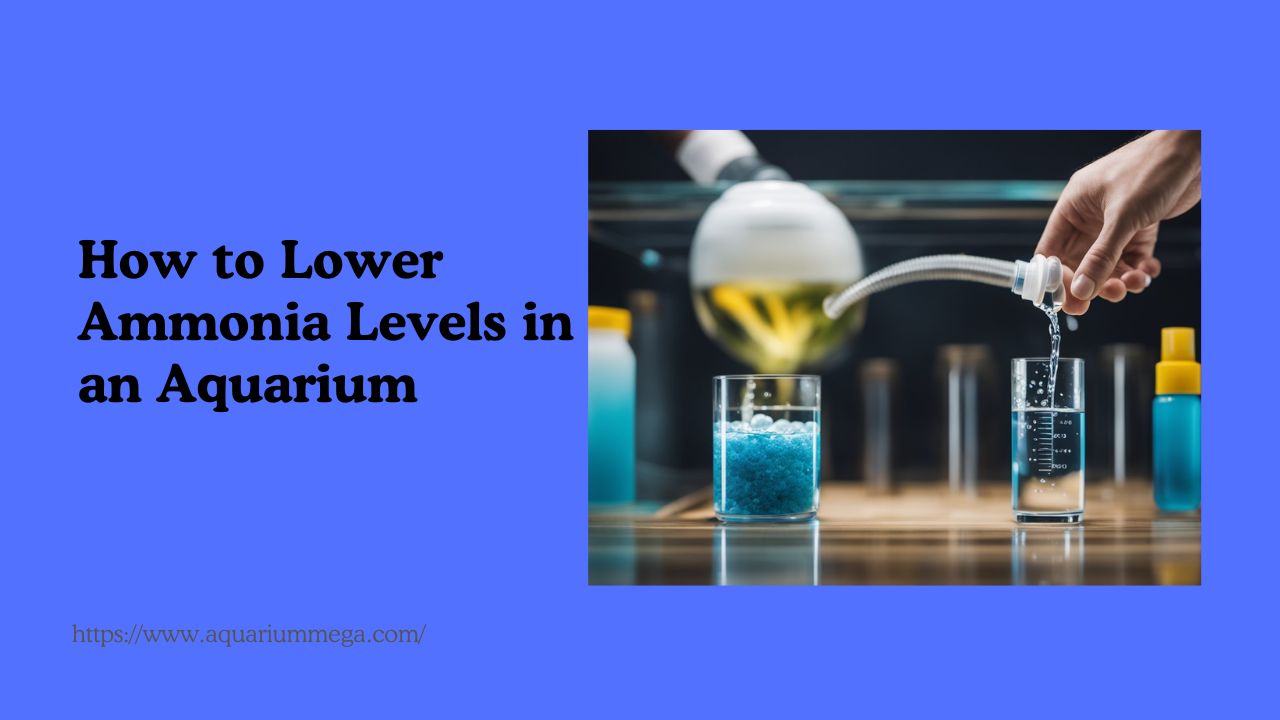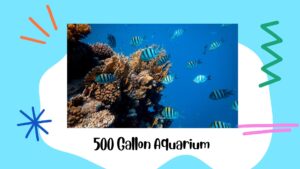Maintaining a healthy aquarium is essential for the well-being of your fish and plants.
To lower ammonia levels in an aquarium, I recommend regular water changes, using a reliable filtration system, and adding beneficial bacteria.
These steps are crucial because high ammonia levels can lead to stress and illness in your aquatic life.

I understand that ammonia can build up quickly from decaying food, fish waste, and other organic matter.
It’s important to test the water regularly to catch any spikes early.
By taking proactive measures, I can ensure that my tank stays balanced and thriving.
Lowering ammonia levels not only protects my fish but also creates a cleaner environment for everything in the tank.
With the right strategies in place, I can keep my aquarium flourishing and enjoying my underwater world.
Contents
- 1 Table of Contents
- 2 Understanding Ammonia in Aquariums
- 3 Testing Ammonia Levels
- 4 Preventing Ammonia Buildup
- 5 Immediate Interventions
- 6 Biological Solutions
- 7 Chemical Filtration Methods
- 8 Ongoing Ammonia Management
- 9 FAQs:
- 9.1 What are the main causes of high ammonia levels in an aquarium?
- 9.2 How can I quickly lower ammonia levels in my aquarium?
- 9.3 Can plants help reduce ammonia levels in an aquarium?
- 9.4 How often should I test ammonia levels in my aquarium?
- 9.5 What are the long-term strategies for preventing ammonia spikes?
Table of Contents
Understanding Ammonia in Aquariums
To maintain a healthy aquarium, it’s crucial to understand ammonia and its role in aquatic environments.
Ammonia is harmful to fish, and knowing its sources, the nitrogen cycle, and the effects of high levels can help prevent crises.
The Nitrogen Cycle
The nitrogen cycle is a natural process that breaks down waste products in an aquarium.
It involves beneficial bacteria converting toxic ammonia into less harmful substances.
- Ammonia production: Fish waste, uneaten food, and decaying plant matter release ammonia.
- Nitrosomonas bacteria: These bacteria convert ammonia into nitrites, which are still harmful but less so than ammonia.
- Nitrobacter bacteria: Next, these bacteria convert nitrites into nitrates, which are much safer for fish.
Regular monitoring of ammonia levels helps me ensure that the cycle is functioning properly.
Sources of Ammonia
Ammonia can enter the aquarium from several key sources.
- Fish waste: As fish excrete waste, ammonia builds up in the water.
- Uneaten food: Leftover food decomposes, contributing to ammonia levels.
- Plant decay: Dead or decaying plants also release ammonia into the water.
- Tap water: Some tap water may contain ammonia.
I often implement partial water changes and avoid overfeeding to combat ammonia buildup.
Effects of High Ammonia Levels
High ammonia levels can severely harm fish and other aquatic life. The key effects include:
- Toxicity: Even small amounts of ammonia can stress fish. It can cause breathing difficulties and reduce their ability to absorb oxygen.
- Health issues: Prolonged exposure leads to health problems like gill damage, skin burns, and even death in severe cases.
- Behavior changes: Fish may become lethargic or show erratic swimming patterns when ammonia levels rise.
To protect my fish, I always monitor ammonia levels and act quickly if they rise above the safe range of 0 to 0.25 ppm.
This vigilance ensures a safe and thriving environment for my aquatic life.
Testing Ammonia Levels
Testing ammonia levels is essential for maintaining a healthy aquarium. Accurate readings help me identify issues before they become serious problems for my fish.
This process involves selecting the right test kit and understanding the results I obtain.
Selecting Ammonia Test Kits
When choosing an ammonia test kit, I consider a few key options.
Liquid test kits are popular for their accuracy. They usually involve adding reagents to a water sample and comparing the color change to a chart.
Test strips are quicker but can be less accurate.
I prefer kits that measure both ammonia and nitrite for a complete picture. Well-known brands offer reliable tests that I trust for consistent results.
It’s also helpful to check the expiration date on the kit; expired kits can give false readings.
Interpreting Test Results
After testing, I read the color against the provided chart to determine the ammonia level.
The ideal ammonia level in my aquarium should be 0 ppm.
If I find levels between 0.25 to 0.5 ppm, I know it’s time to act quickly.
Higher levels indicate serious issues like overfeeding or inadequate filtration.
I may schedule a partial water change or consider adding beneficial bacteria to help reduce ammonia.
It’s essential to monitor my levels regularly, ideally once a week, to prevent any toxic buildup and ensure a healthy environment for my fish.
Preventing Ammonia Buildup
To keep ammonia levels low in my aquarium, I focus on regular maintenance, proper feeding practices, and managing aquarium stocking density.
These steps are essential for creating a healthy environment for my fish.
Regular Maintenance
I find that keeping a consistent maintenance schedule is key.
Regular water changes help remove waste and excess nutrients. I aim to change 10-20% of the water weekly, depending on my tank size and fish load.
I also clean the substrate and decorations to minimize organic buildup.
Using a gravel vacuum during water changes is effective.
Additionally, maintaining the filter is crucial.
I check and replace filter media as needed to ensure efficient ammonia removal.
Proper Feeding Practices
Feeding my fish the right amount is vital.
I avoid overfeeding by giving small portions that my fish can consume in a few minutes. This helps reduce leftover food that can decay and release ammonia.
I also choose high-quality fish food to improve digestion and nutrient absorption.
Sometimes, I fast my fish for a day to allow their systems to clear.
This practice helps maintain a healthy balance in my aquarium.
Aquarium Stocking Density
Managing how many fish I keep in my aquarium is essential.
I follow the one inch of fish per gallon rule as a general guideline. This helps me avoid overcrowding, which can raise ammonia levels.
To better ensure a healthy environment, I consider the species’ adult sizes and behaviors. Some fish require more space than others.
I regularly evaluate my tank’s population to prevent issues that lead to ammonia buildup.
Immediate Interventions

When dealing with high ammonia levels in an aquarium, quick action can make a significant difference. I will focus on two effective methods: performing partial water changes and using ammonia detoxifying products.
Both approaches are essential for maintaining a safe environment for aquatic life.
Partial Water Changes
One of the quickest ways to reduce ammonia levels is by doing partial water changes.
I recommend replacing 25% to 50% of the tank water, depending on the severity of the situation.
Steps for a Partial Water Change:
- Prepare Replacement Water: Use dechlorinated water at the same temperature as the tank.
- Siphon Out Old Water: Use a siphon to remove water, cleaning any debris from the substrate.
- Add New Water: Slowly pour in the prepared water to avoid stressing the fish.
Regular partial water changes not only help lower ammonia concentrations but also maintain overall water quality.
It’s important to monitor levels afterward to ensure they remain stable.
Ammonia Detoxifying Products
Using ammonia detoxifying products can provide immediate relief from high ammonia levels.
I prefer products that convert ammonia into less harmful substances.
Key Features of Detoxifying Products:
- Fast Acting: Many products work instantly, making them useful for emergencies.
- Safe for Fish: These options are formulated to be non-toxic to aquatic life.
- Buffering: Some products help stabilize pH, which can be beneficial.
Before using any detoxifying product, I always read the instructions carefully.
Follow up with regular water testing to monitor ammonia levels and ensure a safe environment for my fish.
Biological Solutions

In my experience, using biological solutions is an effective way to lower ammonia levels in an aquarium. Two key methods include adding beneficial bacteria supplements and incorporating live plants.
Beneficial Bacteria Supplements
I find that beneficial bacteria supplements are essential for reducing ammonia.
These bacteria break down harmful ammonia into less toxic substances like nitrite and nitrate.
When starting a new tank or after a water change, adding these supplements can help quickly establish a healthy biological filter.
It’s important to choose high-quality products that contain live cultures.
Follow the instructions on the label for the best results.
Maintaining proper water parameters like temperature and pH can also enhance their effectiveness.
Periodically adding these bacteria can keep ammonia levels in check, making for a healthier tank environment.
Live Plants
Incorporating live plants into my aquarium has proven beneficial in managing ammonia levels.
Plants naturally absorb ammonia as a nutrient for growth.
This process not only helps lower ammonia concentrations, but also improves the overall water quality.
Choosing fast-growing plants can enhance this effect.
Examples such as duckweed, hornwort, and water sprite are great choices.
I ensure these plants are well-groomed to promote optimal health and uptake.
Regular pruning and maintenance are crucial to keep them thriving.
In healthy planted tanks, fish often exhibit more natural behaviors due to improved water conditions.
Chemical Filtration Methods

Chemical filtration is an effective way to manage ammonia levels in an aquarium. I can use specific filtration media to absorb or neutralize ammonia, contributing to a healthier aquatic environment.
Activated Carbon
Activated carbon is a widely used filtration media. It effectively removes toxins, including ammonia, by capturing them in its numerous tiny pores.
When selecting activated carbon, I ensure it is high-quality and designed for aquarium use.
To use activated carbon, I place it in a mesh bag and add it to my filter. Regular changes are needed, typically every four to six weeks, depending on my tank’s waste levels.
This helps maintain its effectiveness in absorbing ammonia and other contaminants.
Zeolite Media
Zeolite is another excellent option for reducing ammonia levels. This material is a natural mineral that binds ammonia molecules, effectively removing them from the water.
I can use zeolite alone or in combination with other filtration methods.
For best results, I place zeolite in my filter or in a mesh bag within my aquarium.
It’s essential to rinse it before use to remove any dust. I also replace zeolite every few weeks to ensure it retains its ammonia-absorbing properties.
This method can significantly enhance water quality in my tank.
Ongoing Ammonia Management

To keep ammonia levels low, I focus on regular monitoring and routine care. These practices help maintain a stable and healthy environment for my aquarium’s inhabitants.
Monitoring Water Parameters
I regularly test the water parameters in my aquarium. This includes checking ammonia, nitrite, and nitrate levels using test kits.
Ammonia levels should stay at 0 ppm to ensure fish health.
I monitor these parameters weekly or bi-weekly. Frequent checks give me a clear picture of the water quality.
If I notice any rise in ammonia, it signals the need for immediate action.
I also keep an eye on pH and temperature, as they influence ammonia toxicity. Maintaining stability in these parameters supports beneficial bacteria that help manage ammonia levels.
Routine Aquarium Care
I establish a routine that includes partial water changes every 1-2 weeks. This practice helps dilute ammonia and other waste products.
During these changes, I replace about 10-20% of the water.
I ensure my filtration system is working effectively. Regularly cleaning filters prevents debris buildup and maintains strong water flow.
A strong filter is essential to support beneficial bacteria that break down ammonia.
Limiting fish food and avoiding overstocking are also crucial.
By following these steps, I create a healthier habitat for my fish and keep ammonia levels in check.
FAQs:
What are the main causes of high ammonia levels in an aquarium?
Overfeeding, overcrowding, and inadequate filtration are common causes. Understanding these factors is essential when learning how to lower ammonia levels in an aquarium.
How can I quickly lower ammonia levels in my aquarium?
Perform partial water changes, use an ammonia-neutralizing product, and check your filter’s functionality. These are effective steps on how to lower ammonia levels in an aquarium.
Can plants help reduce ammonia levels in an aquarium?
Yes, live plants absorb ammonia as a nutrient, which can help lower ammonia levels in an aquarium naturally.
How often should I test ammonia levels in my aquarium?
Test weekly or more frequently if you suspect a problem. Regular monitoring is key to understanding how to lower ammonia levels in an aquarium and maintaining a healthy tank.
What are the long-term strategies for preventing ammonia spikes?
Avoid overfeeding, maintain proper tank stocking levels, and regularly clean your aquarium. These practices ensure you won’t need to frequently learn how to lower ammonia levels in an aquarium.




